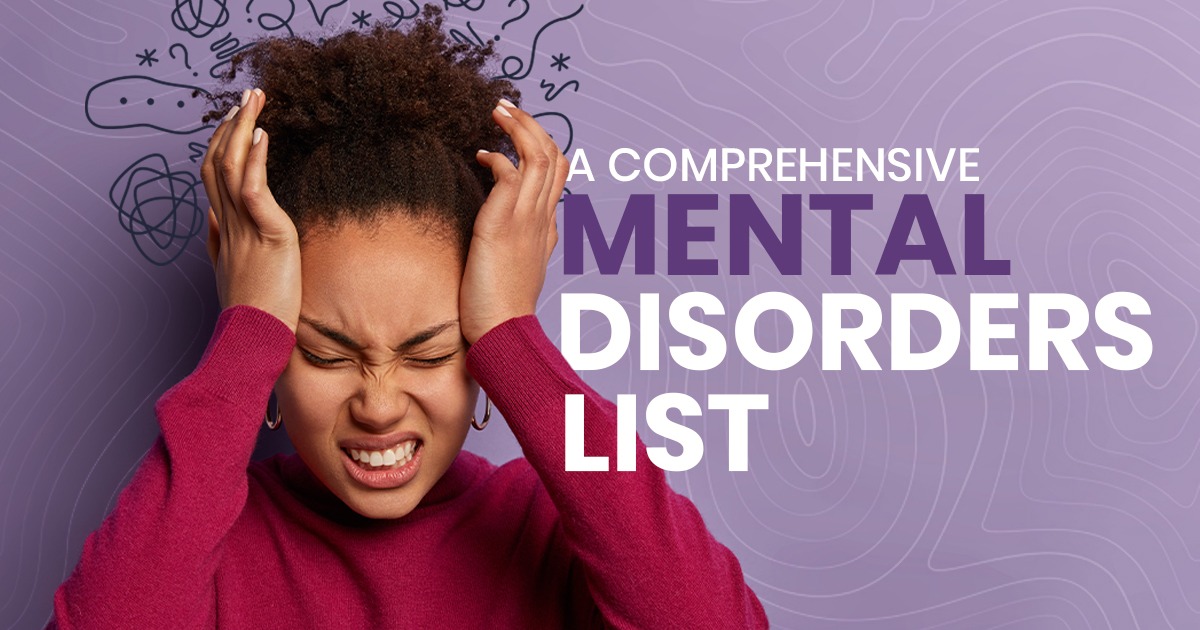It’s estimated that one in five adults in the United States lives with a mental illness, making mental health a critical issue for individuals and communities alike. Mental disorders can take many forms, and their symptoms can range from mild to severe. It is important to be aware of the various types of mental disorders that exist in order to better understand and support those who may be suffering from one, especially if that person is you.
What is a Mental Disorder
According to the American Psychiatric Association, a mental health disorder or psychiatric disorder is characterized by a disturbance in cognition, behavior, or emotional regulation. The mental disorders list is fairly lengthy, but some of these conditions are more commonly diagnosed than others.
Mental disorders are also referred to as mental illnesses or mental health conditions. In 2019, according to the World Health Organization, around 970 million people globally were living with a mental disorder. Anxiety and depressive disorders were most common.
The COVID-19 pandemic led to a substantial increase in these numbers, with initial estimates showing a 26% increase in anxiety disorders and a 28% increase in major depressive disorders.
Many factors play a role in the development of mental health disorders. For example, environmental factors, family history, medical history, co-occurring substance use disorders, brain structure, and brain chemistry play a role.
Below is a brief mental disorder list of some of the most common conditions, although it’s not an exhaustive list.
Anxiety Disorders
Anxiety disorders are a grouping of mental health conditions that include:
- Generalized anxiety disorders
- Social phobia (social anxiety disorder)
- Specific phobias
- Panic disorders
- Post-traumatic stress disorder
- Obsessive-compulsive disorder (OCD)
When someone has an anxiety disorder, they have ongoing worries that interfere with their daily activities, including school, work, social interactions, and relationships.
Someone with an anxiety disorder will often know their worries are exaggerated or not realistic, but they can’t control them.
Medications such as antidepressants and talk therapy like cognitive behavioral therapy can help people with anxiety disorders.
Behavioral and Emotional Disorders in Children
There are a couple of primary behavioral and emotional disorders in children. There is attention-deficit hyperactivity disorder (ADHD), oppositional defiant disorder (ODD), and conduct disorder (CD).
- All children experience times of impulsivity and defiance, and that’s normal.
- When children have difficulty controlling their behaviors and are consistently outside of the norm for their age, it could indicate a behavioral disorder.
- Boys are more likely than girls to have behavioral disorders.
- Other risk factors include family life, learning challenges, and intellectual disabilities.
- Sometimes autism spectrum disorder might be included on this list, but it can also be categorized on its own as well because of the distinct diagnostic criteria.
Bipolar Disorder
Once called manic depression, bipolar is a mental health condition. Bipolar disorder symptoms include severe mood episodes and mood swings. Someone with bipolar might have emotional highs known as mania or hypomania. Then, they may have extreme lows or periods of depression, losing interest in most activities.
- There are a few types of bipolar disorders, and the condition is most often diagnosed when someone is in their teens to their early 20s.
- Bipolar is considered a chronic, lifelong condition, but it’s manageable with medication, therapy, and lifestyle modifications.
- Symptoms of a manic episode in bipolar can include being abnormally upbeat or energetic. Someone may seem extremely talkative, have an exaggerated sense of self-confidence, appear euphoric, or have a reduced need for sleep. Episodes of mania can also lead to risky decision-making. For example, someone in a period of mania with bipolar might spend excessive money or engage in sexually risky behavior.
- A hypomanic episode has similar but less severe symptoms to a manic episode.
- During a depressive episode, someone may feel sad, empty, or hopeless. They may feel no pleasure from activities and experience changes in sleeping or eating habits and low energy levels. These symptoms are essentially the opposite of manic symptoms.
Major Depression
Depression, also known as major depressive disorder, is a mood disorder. Depression is fairly common and affects how someone feels, thinks, and acts.
- Symptoms include feeling sad, fatigued, feeling guilty or worthless, social withdrawal, and problems thinking or making decisions.
- In severe cases, depression can lead to the risk of suicide.
- To receive a diagnosis of depression, symptoms have to last at least two weeks. Depressive symptoms also have to indicate a change in function from someone’s previous level.
- Several physical health conditions mimic severe depression, including vitamin deficiency or thyroid problems, so these may need to be ruled out.
Premenstrual dysphoric disorder or PMDD is a similar mood disorder that was added to the Diagnostic and Statistical Manual of Mental Disorders (DSM-5) in 2013. Common symptoms of PMDD include depression, tension, and irritability around a week before menstruation.
Disruptive mood dysregulation disorder is a mood disorder occurring in children and teens that involves ongoing and severe irritability leading to extreme temper outbursts.
Persistent depressive disorder was at one point referred to as dysthymic disorder. This condition leads to a depressed mood most of the day for at least two years, on more days than not.
Dissociative Disorders
A dissociative disorder means someone has a disconnect between their thoughts, memories, identity, and surroundings.
- Someone with a dissociative disorder might involuntarily escape reality.
- It can be unhealthy and impact daily functionality.
- People may develop dissociative disorders in response to trauma to keep their troubling memories away.
- Symptoms of dissociative disorders can include memory loss of certain periods, the feeling of being detached from yourself and your emotions, and a blurred sense of your identity.
Eating Disorders
Eating disorders are serious medical conditions and mental health disorders that are treatable with the appropriate treatment plan. Around 20 million women in the United States and ten million men are estimated to have an eating disorder during their life at some point.
Eating disorders are characterized by severe, persistent changes in eating behaviors and distressing thoughts and emotions. Physical symptoms of eating disorders can be deadly, especially those that stem from anorexia nervosa.
Specific eating disorders include:
- Anorexia nervosa
- Bulimia nervosa
- Binge eating disorder (BED)
- Avoidant restrictive food intake disorder
- Rumination disorder
- Pica
Personality Disorders
Personality is our way of thinking, behaving, and feeling, which sets us apart from others. Your personality is influenced by various factors, including your environment, experiences, and genetics.
- When someone has a personality disorder, their thoughts, behaviors, and feelings deviate from cultural expectations, causing problems in functioning.
- There are ten personality disorders. Examples are borderline personality disorder and another antisocial personality disorder.
- A personality disorder affects how someone thinks about themselves and others, their emotional responses, how they relate to others, and how they control their behavior.
Schizophrenia
Schizophrenia is a rare, serious brain disorder affecting less than 1% of the U.S. population.
- The symptoms of schizophrenia include delusions and hallucinations, problems with thinking, disorganized speech, and a lack of motivation.
- Schizophrenia is sometimes categorized as a psychotic disorder.
- A person may experience psychotic symptoms, which are a set of symptoms that are defined by a loss of touch with reality.
- Someone may have difficulty understanding what’s real and what isn’t during a psychotic episode.
- As a delusional disorder, symptoms include false beliefs that someone holds even though there’s evidence they’re untrue.
- Hallucinations are when someone experiences something that’s not there. Auditory hallucinations, which can mean hearing voices, are most common in schizophrenia.
Schizophrenia symptoms can be considered positive or negative.
- Positive symptoms are things that are abnormally present, like hearing voices.
- Negative symptoms are abnormally absent, such as an inability to find pleasure.
- There are also disorganized symptoms, including abnormal movements or strange behaviors.
Schizoaffective disorder is similar to schizophrenia, but it also includes mood disorder symptoms of depression or mania.
Effective treatments, including antipsychotic medications and therapy, can improve daily functioning.
Mental Health Treatment in Orange County, CA
No matter the particular type on this mental disorders list, the symptoms, or what someone is going through, these are treatable conditions by our mental health care providers. Medications, talk therapy, and other interventions are extremely beneficial for any of the above on the list of mental disorders and their symptoms. Please contact Story Wellness at (866) 476-2823 to learn more about available treatment options available in Orange County, CA.




